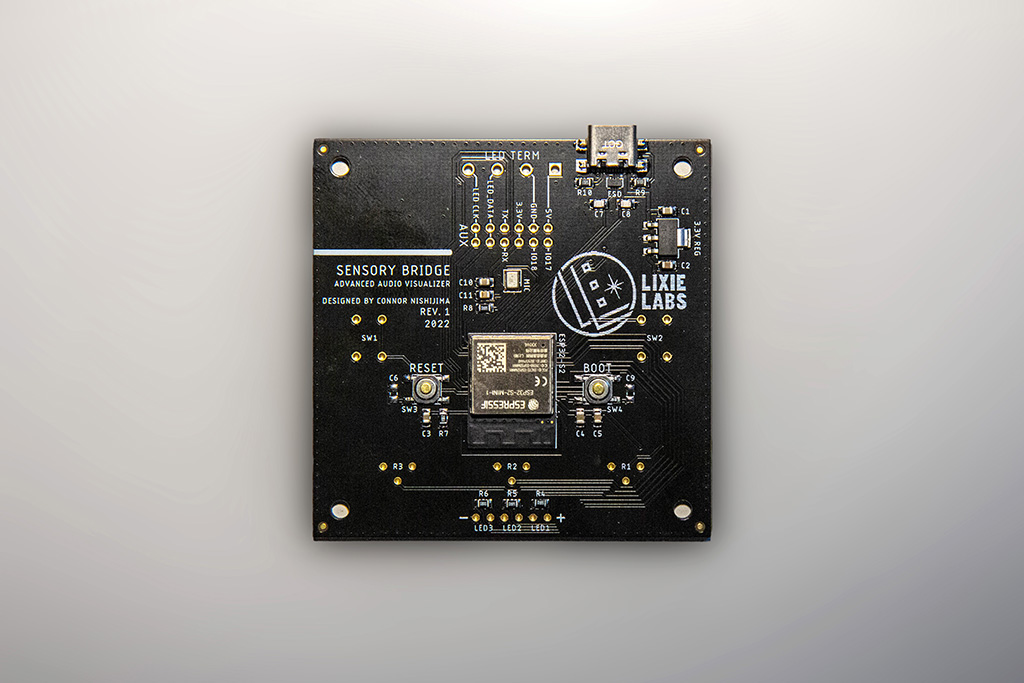Sensory Bridge // An Advanced LED Music Visualizer
Sold by Lixie Labs
$60.00
No tax for United States [change]
Mini Masts are available on backorder now!
SENSORY BRIDGE is DIFFERENT
This isn't the usual "sound-reactive LEDs" you've seen for years.
Sensory Bridge is built from the ground up as an open, powerful bridge between sight and sound. With a show that's reactive to notation, vibrato and more, it produces very unique and pleasant-to-look-at light shows which synchronize to your music without any visible latency. (A built-in MEMS microphone constantly studies what it hears using a special-sauce Goertzel-based Discrete Fourier Transform, at 100 FPS!)
It has to be seen to be believed, which the video demos below can help with:
(NOTE: The below demos are from the 1.X firmware. Here are two demos of the current 3.X firmware!)

SENSORY BRIDGE is SIMPLE
Easy controls provide quick access to changing the brightness, color, and smoothing of the display!
KNOBS
PHOTONS KNOB
Too bright? Dim down the show with the PHOTONS knob. The FastLED code in the firmware will use dithering to keep producing color nicely at lower brightness levels.
CHROMA KNOB
Custom color or automated color based on the music's notation? Choose with the CHROMA knob, where turning it all the way to the top enables Chromatic Mode.
MOOD KNOB
This knob is special. MOOD controls how quickly your LEDs will react to changes in pitch and volume! A low "mood" will be very soft and gradual, only showing things like the underlying chord progression of a song, whereas a high "mood" will be extremely reactive, and can be a little too flashy for some people's liking. Luckily, you can blend the value to anywhere between those two extremes whenever you want to find what look you prefer!

BUTTONS
NOISE BUTTON
Running the A/C? Is the washing machine suddenly on the spin cycle? Don't worry, just pause the music for a moment and press the NOISE BUTTON to run a 3-second calibration to automagically have noisy background ambience removed from your light show.
MODE BUTTON
Sensory Bridge currently has 6 powerful lightshow modes that you can cycle through with a tap, or long-press to toggle mirrored versions!

SLEEK CONFIGURATION TOOLS
Also available is an extremely helpful configuration tool available at settings.sensorybridge.rocks. This tool lets you fine-tune your settings, such as the LED strip type and length, the range of frequencies your Sensory Bridge is interested in, and more!

SWEET SPOT
At the front of the base unit are three LEDs, which indicate if your music is playing too quietly for the auto-ranger to account for, or if it's too loud! (Close to clipping!)

SENSORY BRIDGE is FLEXIBLE
While compatible with any WS2812B or APA102/SK9822-based LED strip (just use the screw terminals at the back!) there's also the option of using the "Mini Mast", a dense strip of 128 1.5mm RGB LEDs on a 260mm long PCB! It just plugs directly into the Sensory Bridge accessory port, making for a very portable solution!

SENSORY BRIDGE is OPEN
Powered by an ESP32-S2, Sensory Bridge can be easily reprogrammed for any purpose you'd like! The firmware is open source under the MIT License, so modifying it for your own purposes is quick and easy with the Arduino IDE. You can even download the board and case STLs to build one yourself!

WHAT'S INCLUDED:
For $60, you'll receive a fully assembled Sensory Bridge, with the latest firmware already installed. For $35 extra, you can have a Mini Mast (128 micro-LED PCB, seen above) sent as well, with an accompanying brace that provides rigidity. (It just plugs right into the accessory port on top of Sensory Bridge!)
(MINI MAST AVAILABLE AGAIN MID-MAY 2023)
EXTRAS YOU MIGHT NEED:
PAY CLOSE ATTENTION TO THIS SECTION!
To save on redundant materials you might already own, your Sensory Bridge does not come with the following items:
- WS2812B LED Strip - "144-LEDs per meter" variants are recommended, you can cut the 16 excess LEDs off of the end of the strip or reconfigure your device to interpolate to the 144-LED length at a slightly lower frame rate. (AMAZON LINK)
- USB-C Cable (AMAZON LINK) I've verified that this specific cable has data lines inside it, some cables ONLY carry power, making firmware updates impossible. Avoid those cables if at all possible.
- 5V, 2A USB Power Adapter (AMAZON LINK)
- Wire Stripper - If you'd like to use your Sensory Bridge with your own LED strip, you'll either need a wire stripper or strong teeth to get it hooked up neatly! These clamp-style strippers make that process a breeze, so please don't use your teeth: (AMAZON LINK)
GETTING STARTED
The GETTING STARTED GUIDE will walk you through the quick-and-easy setup process!
Links to code and documentation
Certified Open Source Hardware - OSHW US002125
Shipping policy
As of 6/5/23, Lixie Labs is manufacturing your orders on the fly:
https://twitter.com/lixielabs/status/1665834294026141701
The seller
I'll say it: it's the best LED music visualizer you can buy.
http://sensorybridge.rocks
















